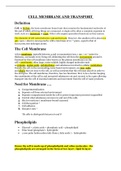CELL MEMBRANE AND TRANSPORT
Definition
Cell, in biology, the basic membrane-bound unit that contains the fundamental molecules of
life and of which all living things are composed. A single cell is often a complete organism in
itself, such as a bacterium or yeast. Other cells acquire specialized functions as they mature.
The diameter of cell varies between 1 μm and 100 µm. However, the smallest cell is about 0.2
µm. (1μm = about 0.000039 inch), with a total mass of 10 −14 gram—equal to that of
8,000,000,000 hydrogen atoms.
The Cell Membrane
A thin membrane, typically between 4 and 10 nanometres (nm; 1 nm = 10 −9 metre) in
thickness, surrounds every living cell, delimiting the cell from the environment around it.
Enclosed by this cell membrane (also known as the plasma membrane) are the
cell’s constituents, often large, water-soluble, highly charged molecules such
as proteins, nucleic acids, carbohydrates, and substances involved in cellular metabolism.
Outside the cell, in the surrounding water-based environment, are ions, acids,
and alkalis that are toxic to the cell, as well as nutrients that the cell must absorb in order to
live and grow. The cell membrane, therefore, has two functions: first, to be a barrier keeping
the constituents of the cell in and unwanted substances out and, second, to be a gate allowing
transport into the cell of essential nutrients and movement from the cell of waste products.
Need for Membrane .…
1. Compartmentalization
2. Separate cell from external environment
3. Separate compartments inside the cell to protect important processes (organelles)
4. Control what substances can move in and out of the cells
5. Site for reactions ( membrane-bound enzymes)
6. Cell Recognition *
7. Cell adhesion
8. Receptor sites *
*Be able to distinguish between 6 and 8
Phospholipids
Glycerol + 2 fatty acids + phosphoric acid = phospholipid
Polar head (phosphate) - hydrophilic
2 non-polar hydrocarbon tails (from 2 fatty acids ) – hydrophobic
Hence the cell is made up of phospholipids and other molecules . the
phospholipids are arranged in the form of two layer / lipid bi-layer.
,





